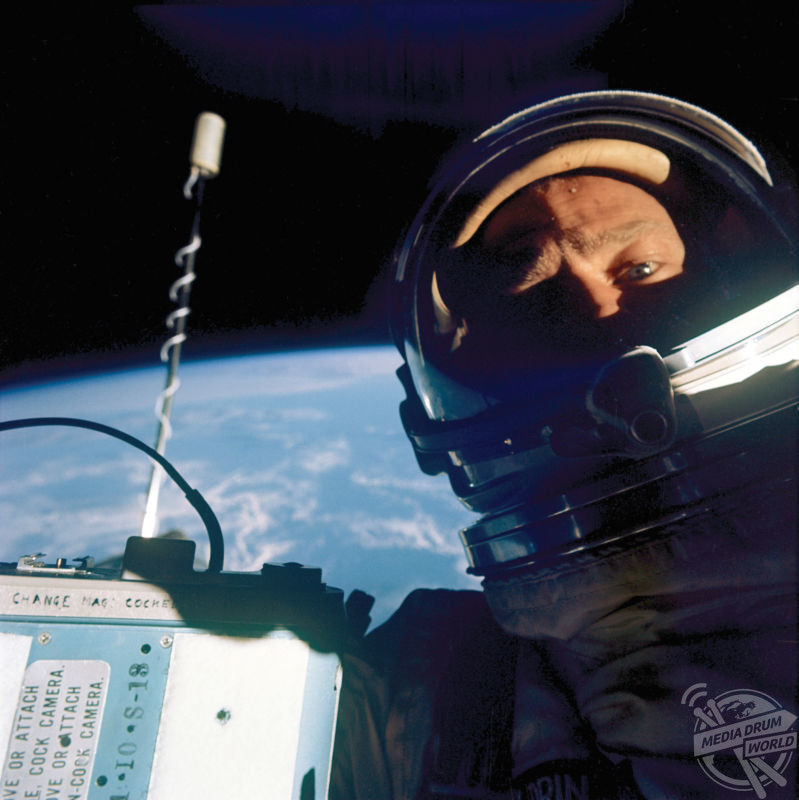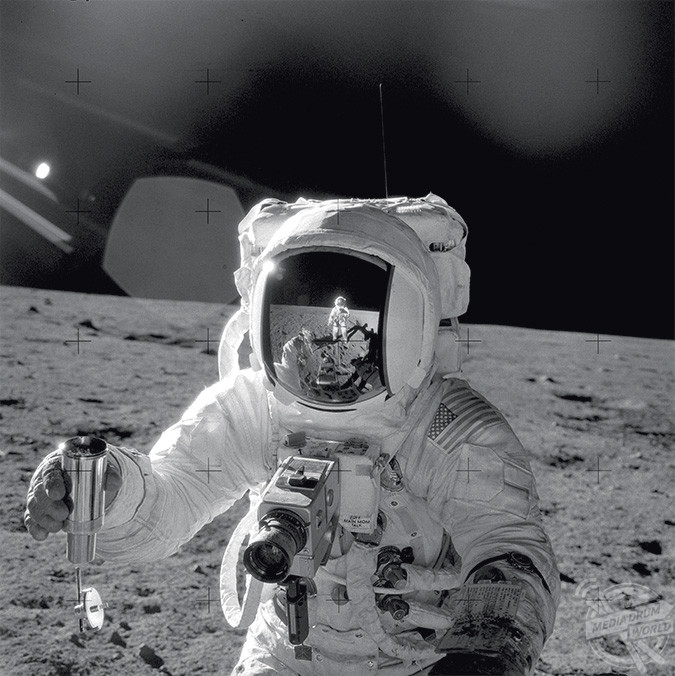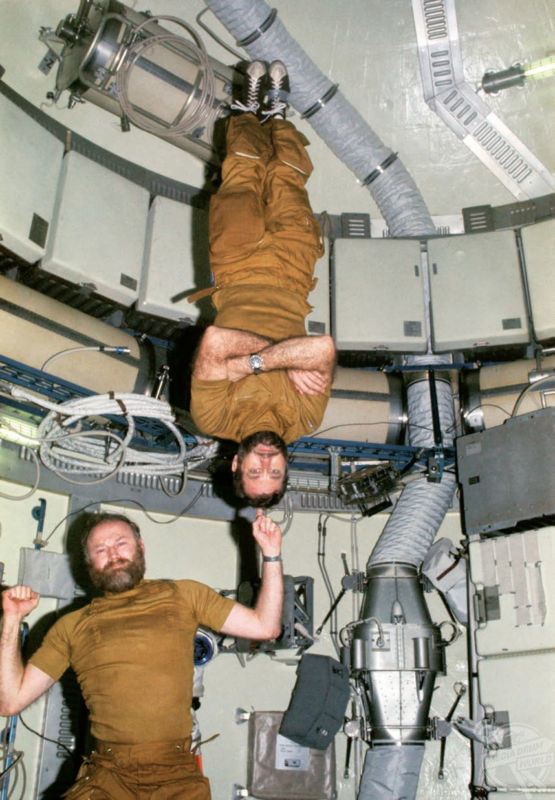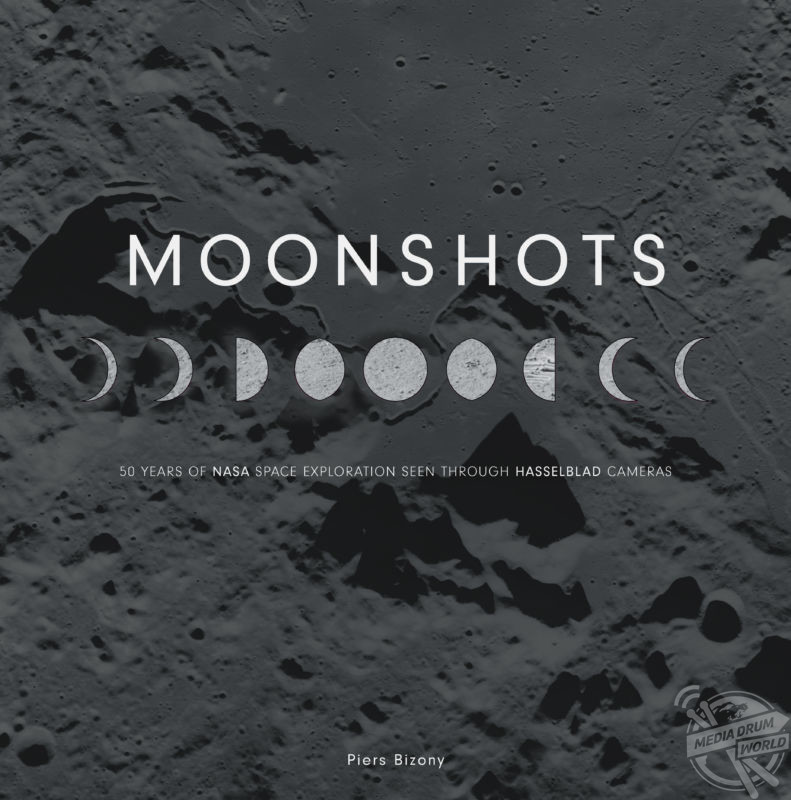
By Alex Jones
BEAUTIFUL cosmic photos capture the ethereal qualities of the moon’s jagged landscape and explore the mysteries of six decades of space exploration fifty years after man first set foot on the moon.
On July 21, this year, at 2.56am, it will be exactly five decades since Neil Armstrong became the first man to firmly plant his foot in the Sea of Tranquility as well as the history books.
To celebrate one of the pinnacles of human achievement, Piers Bizony has compiled Moonshots: 50 Years of NASA Space Exploration Seen Through Hasselblad Cameras – an outrageously handsome book that brings the story of America’s journey into space to life.

successful Gemini XII spacewalk. He became the second man to set foot on the moon fifty years ago. Mediadrumimages/NASA/PiersBizony
The exquisite images, many snapped by the astronauts themselves, include an out-of-this-world selfie of Buzz Aldrin on a spacewalk, Armstrong’s famous lunar bootprint, and a dusty set of tyre trails created by one of Nasa’s magnificent moon buggies, all captured in rich, eye-catching detail.
As time passes and those remarkable men and women who made stepping on the moon a reality pass away – only four of the 12 men who have walked on the Moon still walk on Earth – this timely publication captures the joy, terror and wonder of NASA’s cosmic operations.
“In this age of infinite information, what could be more familiar to us than those famous photos of men walking on the moon?” asks Bizony.
“At the same time, what could be less familiar than the hazardous visit to an airless alien landscape a quarter of a million miles away, conducted by just twelve people in all the world?
“It is not just distance but time that separates us from the achievements of this special dozen. Their bootprints, undisturbed to this day in the lunar soil, were tramped down half a century ago, before most of the seven billion people now alive were born; and of those twelve explorers, who were not precisely young when they reached the moon, only four (as of early 2019) are still with us to recount their stories first-hand.

“In 1999 Full Moon – a book which revisited some of the Apollo missions first photos and digitalised them for a new audience – was a significant achievement, and Moonshots aims to serve as a companion piece by focusing precisely on those more famous images that everyone thinks they have already seen.
“In the two decades since Full Moon first appeared, the relationship between film archives and digital interpretation has continued to evolve, and we think that yet another “performance” of historic NASA images is justified.
“We also believe that printing the results on paper is important. Long after the world’s fleeting electronic archives have been lost or deleted, surviving copies of this book will stand (with other similarly respectful volumes) as a testimonial to America’s first decades in space.
“Stored carefully, these pages should stay almost as pristine as the film frames in NASA’s vaults.”
Although many of the photos in this remarkable book have been seen before in one guise or another, they have never been as expertly or lovingly rendered as they have been here. Some have only been seldom seen, if at all.
After carefully selecting the most striking photos of NASA’s collection, Bizony also uses his book to answer a few of the questions from the conspiracy theorists that these publications tend to attract.
“There just isn’t such a huge range of shots for picky editors to select from out of the Apollo haul, and that’s why, over the years, we have tended to see the same ones reproduced time and again,” he explained.

the third and final crew to visit
Mediadrumimages/NASA/PiersBizony
“A wonderful myth has gotten hold of some conspiracy enthusiasts. How could those lunar photos be real when they are so suspiciously perfect, as if created in a studio? If the doubters took the time to look through more than eight thousand frames retrieved from the handheld cameras of Apollo, and if they would only put themselves in the position of an art director trying to design a saleable print product, they would struggle to select more than a few hundred that would pass muster. The sun’s glare too often spoiled a shot. The spacesuits were so white and reflective they tended to bleach out, and so on. The astronauts were swamped by NASA’s incessant demand for science tasks and had to point and shoot their cameras swiftly, without help from a viewfinder, while getting on with other work.
“It’s amazing that they brought back as many good photos as they did, and much of the credit belongs to the cameras they wielded. Wally Schirra, one of NASA’s first team of astronauts, bought a Hasselblad roll film camera manufactured in Sweden and took it with him on his orbital flight aboard a one-man Mercury capsule in October 1962. His shots of Earth, hastily snapped through his tiny window, convinced NASA that Schirra had discovered a powerful tool, not just for space science but for public relations too.
“The film frames were large (two and a quarter inches square), yet the camera was surprisingly compact and mechanically rugged. The Carl Zeiss lenses were formidably sharp. Best of all, the Hasselblad was easy to reload.
“It was almost as if they had been designed with space explorers in mind.”
This idea is explored in Moonshots, as various ‘wonky’ shots make the cut. These unusual shots are composite images made by hurried astronauts snapping multiple photos in close succession – a retro panoramic.

But Moonshots also asks what is next for humanity and the stars? It has been 47 long years since a human being (Gene Cerman) last walked on lunar soil. Bizony believe the answer, or at least the inspiration, lays within these stunning images.
“The photographs taken on film by American astronauts five decades ago still have the power to amaze us, in our digital age. They are a vivid reminder of past achievements, but also lay down a challenge for the future,” he said.
“Are we destined to go back to the moon? Are we supposed to set up camp on Mars? Such a goal may lie beyond this generation’s capabilities, no matter what the Red Planet’s fans try to tell us. We could get to Mars, but surviving there (and coming home again afterward) is another story.

“Are we supposed to hunt down asteroids? Not according to those who say that robotic probes are better suited to gather simple rock samples. Is the orbital realm where our spacefaring energies should be directed? We don’t know any of the answers right now. Nevertheless, instinct impels us to believe that human space flight should continue, somehow, some way, for reasons as yet unclear.
“All we do know is that if humans stopped venturing into space, we would mourn the loss of that capability and feel ourselves lessened as a species. Cash is not the problem. There is always enough money in the world to accomplish pretty much anything we want to, and still keep everyone fed. We could solve all the technical problems about life support and radiation too. The apparent holdup in our bid to become a spacefaring species is political, not mechanical. It is not (and never has been) NASA’s job to tell us where we should go next in space. The role of this government agency is to carry out national space policy, not to determine it.
“Essentially, that choice belongs to the American people, and to their international allies. It belongs, dear reader, to you.”
Piers Bizony’s Moonshots: 50 Years of NASA Space Exploration Seen Through Hasselblad Cameras, republished by the Quarto Group to mark the 50th anniversary, is available here.






